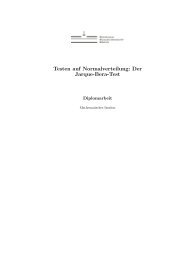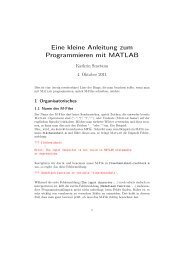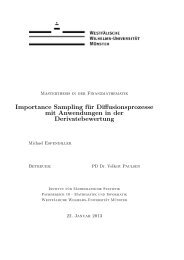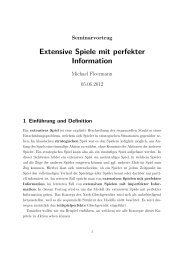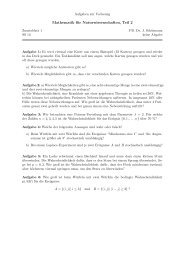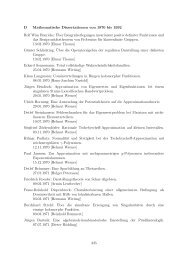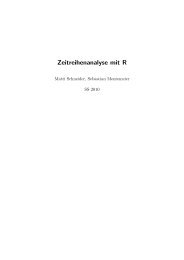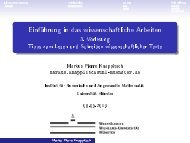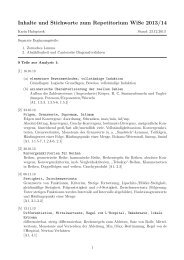Margulis Lemma
Margulis Lemma
Margulis Lemma
You also want an ePaper? Increase the reach of your titles
YUMPU automatically turns print PDFs into web optimized ePapers that Google loves.
STRUCTURE OF FUNDAMENTAL GROUPS 33<br />
Actually, we will only show that M is homotopically equivalent to an infranilmanifold.<br />
By work of Farrell and Hsiang [FH83] this determines the homeomorphism<br />
type in dimensions above 4. The 4 -dimensional case follows from work of<br />
Freedman–Quinn [FQ90]. Lastly, the 3-dimensional case follows from Perelman’s<br />
solution of the geometrization conjecture.<br />
Proof of Corollary 7.1. Notice that it suffices to prove that M i is aspherical for<br />
large i: In fact, since the cohomological dimension of a rank n nilpotent group<br />
is n, the group π 1 (M i ) must then be a torsion free virtually nilpotent group of<br />
rank n and thus, by a result of Lee and Raymond [LR85], it is isomorphic to the<br />
fundamental group of an infranilmanifold. Therfore M i is homotopically equivalent<br />
to an infranilmanifold and as explained above this then gives the result.<br />
We argue by contradiction and assume that we can find ε i → 0 and a sequence<br />
of complete manifolds M i with Ric > −1 on B 1 (p i ) such that the image of<br />
π 1 (B εi (p i ), p i ) → π 1 (B 1 (p i ), p i ) contains a nilpotent group of rank n and M i is not<br />
aspherical.<br />
By the <strong>Margulis</strong> <strong>Lemma</strong> (Theorem 1), the nilpotent group can be chosen to<br />
have index ≤ C(n) in the image. Arguing on the universal cover of B 1 (p i ) it is not<br />
hard to deduce that there is δ i → 0 such that for all q i ∈ B 1/10 (p i ) the image of<br />
π 1 (B δi (q i ), q i ) → π 1 (B 1 (p i ), p i ) also contains a nilpotent subgroup of rank n.<br />
Next we observe that diam(M i , p i ) → 0. In fact, otherwise we could, after passing<br />
to a subsequence, assume that (M i , p i ) converges in the Gromov–Hausdorff sense<br />
to (Y, p ∞ ) with Y ≠ pt. Choose q i ∈ B 1/10 (p i ) converging to a regular point q ∞<br />
in the limit Y . Similarly, choose λ i ≤ 1 √ δi<br />
slowly converging to infinity such that<br />
(λ i M i , q i ) → (C q∞ Y, o) = (R k , 0) for some k > 0. Let Ñi denote the universal cover<br />
of B 1 (p i ) and ˜q i a lift of q i . Let Γ i be the subgroup of the deck transformation group<br />
generated by those elements which displace q i by at most δ i . By construction, Γ i<br />
contains a nilpotent group of rank n. Put N i = Ñi/Γ i . Since (λ i N i , q i ) → (R k , 0)<br />
with k > 0, we get a contradiction to the Induction Theorem (6.1).<br />
Thus, diam(M i ) → 0 and in particular, M i = B 1 (p i ) is a closed manifold for all<br />
large i. After a slow rescaling we may assume in addition that Ric Mi ≥ −h i → 0.<br />
Next we plan to show that the universal cover of M i converges to R n . This will<br />
follow from<br />
Claim 1. Suppose a sequence of complete n-manifolds (N i , p i ) with lower Ricci<br />
curvature bound > −h i → 0 converges to (R k × K, p ∞ ) with K compact. Also<br />
assume that π 1 (N i ) is generated by loops of length ≤ R and contains a nilpotent<br />
subgroup of rank n − k. Then the universal cover of (Ñi, ˜p i ) converges to (R n , 0).<br />
We argue by reverse induction on k. The base of induction k = n is obvious.<br />
By the Induction Theorem, after passing to a bounded cover, we may assume<br />
that π 1 (N i ) itself is a torsion free nilpotent group of rank n − k.<br />
Choose N i ⊳ π 1 (N i ) with π 1 (N i )/N i<br />
∼ = Z. Then ( Ñ i /N i , ˆp i ) converges to (R l ×<br />
K ′ , (0, p ∞ )) for some l > k and K ′ compact and the claim follows from the induction<br />
assumption.<br />
Therefore ( ˜M i , ˜p i ) converges to (R n , 0). From the Cheeger–Colding Stability Theorem<br />
(see Theorem 1.2) it follows that for any R > 0 the ball B R (p) is contractible<br />
in B R+1 (p) for all p ∈ B R (˜p i ) and i ≥ i 0 (R). Since we have a cocompact deck



